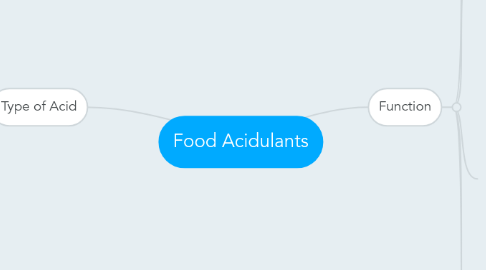
1. Type of Acid
1.1. Inorganic
1.1.1. Phosphoric acid
1.1.1.1. Carboxylic acid
1.1.1.1.1. Monocarboxylic acid
1.1.1.1.2. Dicarboxylic acid
1.1.1.1.3. Tricarboxylic acids
1.1.1.2. Phenolic acids
1.1.1.2.1. Benzoic acid
1.1.1.3. Fatty acids
1.1.1.3.1. Sorbic acid
1.1.1.3.2. Caprylic acid
1.1.1.3.3. Butyric acid
1.1.1.4. Lactones
1.1.1.4.1. Ascorbic acid
1.1.1.4.2. Gluconolactone
1.1.2. Hydrochloric acid
1.1.3. Sulfuric acid
1.2. Organic
2. Function
2.1. pH control agent
2.1.1. Obtain certain pH range in product formulation
2.1.2. Reaction with baking soda in the leavening action of CO2
2.1.3. Acidic pH and tartness of carbonated beverages
2.1.4. Benefit products that use preservatives such as sodium benzoate
2.1.5. Maintain acidic fermentation processes (buffering)
2.1.5.1. Example: citric acid and sodium citrate control amount of free hydrogen ions
2.1.5.2. Citric acid- pH 2.5-6.5
2.1.5.3. Tartaric acid- pH 3.0-4.5
2.2. Preservatives
2.2.1. Stop growth or enhance the effectiveness of heat sterilization or antimicrobial effect
2.2.2. Antibrowning agents- maintain normal flavour, colour and texture.
2.3. Chelating agents
2.3.1. Form ring structure with metal ion (chelation)
2.3.1.1. Example: Citric acid, Lactic, malic and tartaric acid
2.3.2. Prevent metal ion from reacting with other material
2.3.3. Retard enzymatic browning reaction
2.3.4. synergists for antioxidant
2.3.4.1. Example: BHA and BHT ascorbates
2.4. Flavor adjustment
2.4.1. Modify or enhance food flavor
2.4.1.1. Example: tartaric acid with grape flavor, phosphoric acid with cola flavor
2.4.2. Add tartness to balance the excessive sweetness
2.4.2.1. Acetic acid- distinctive vinegar note
2.4.2.2. Citric acid- sharp, clean bite
2.4.2.3. Fumaric acid- acid taste lingers
2.4.2.4. Malic acid- acidity builds slowly but linfers
2.5. Control of gelation and coagulation
2.5.1. Gelation of pectin and algins
2.5.2. pH control for protein coagulation

